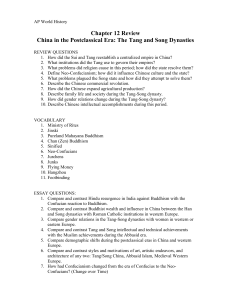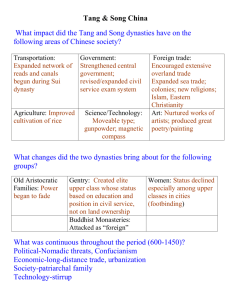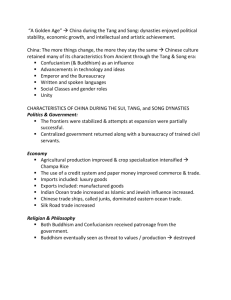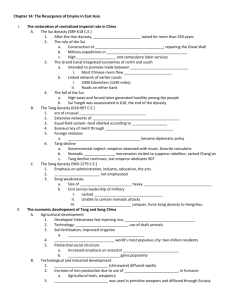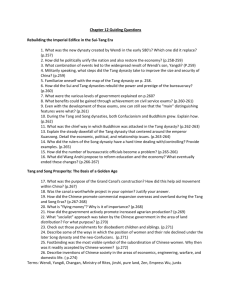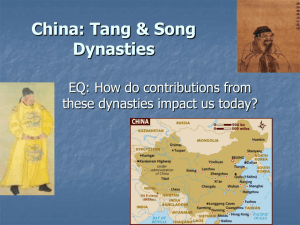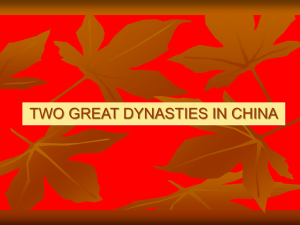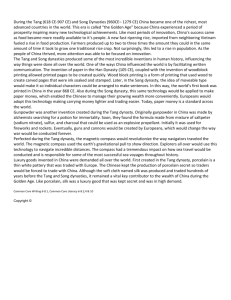chapter 12 reading guide
advertisement
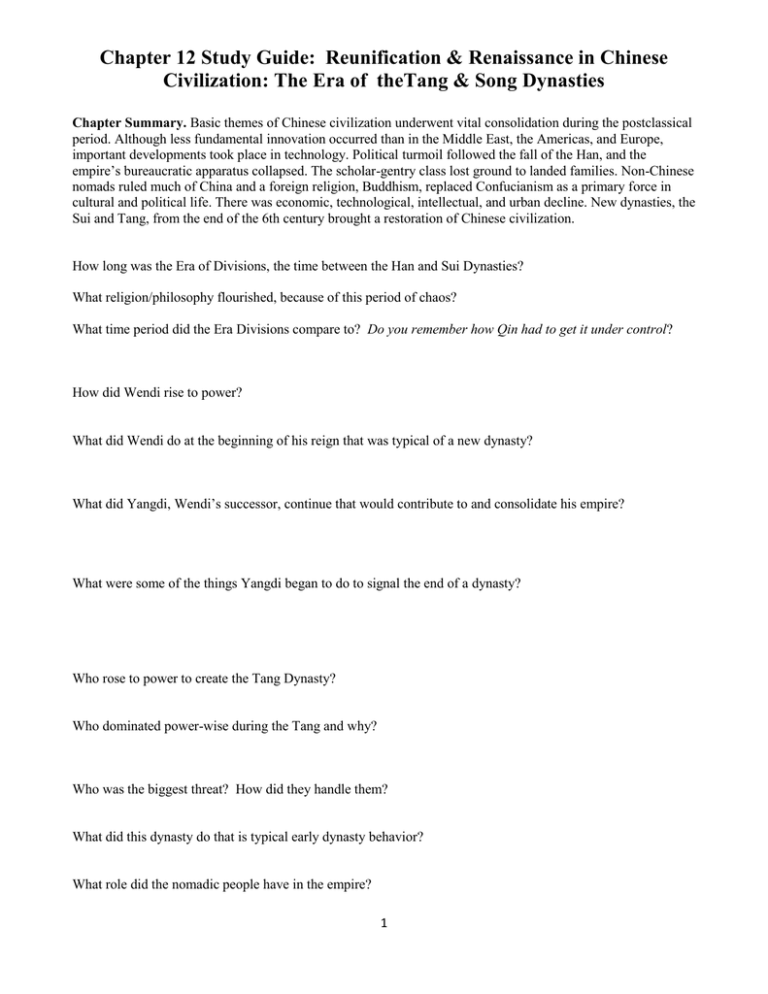
Chapter 12 Study Guide: Reunification & Renaissance in Chinese Civilization: The Era of theTang & Song Dynasties Chapter Summary. Basic themes of Chinese civilization underwent vital consolidation during the postclassical period. Although less fundamental innovation occurred than in the Middle East, the Americas, and Europe, important developments took place in technology. Political turmoil followed the fall of the Han, and the empire’s bureaucratic apparatus collapsed. The scholar-gentry class lost ground to landed families. Non-Chinese nomads ruled much of China and a foreign religion, Buddhism, replaced Confucianism as a primary force in cultural and political life. There was economic, technological, intellectual, and urban decline. New dynasties, the Sui and Tang, from the end of the 6th century brought a restoration of Chinese civilization. How long was the Era of Divisions, the time between the Han and Sui Dynasties? What religion/philosophy flourished, because of this period of chaos? What time period did the Era Divisions compare to? Do you remember how Qin had to get it under control? How did Wendi rise to power? What did Wendi do at the beginning of his reign that was typical of a new dynasty? What did Yangdi, Wendi’s successor, continue that would contribute to and consolidate his empire? What were some of the things Yangdi began to do to signal the end of a dynasty? Who rose to power to create the Tang Dynasty? Who dominated power-wise during the Tang and why? Who was the biggest threat? How did they handle them? What did this dynasty do that is typical early dynasty behavior? What role did the nomadic people have in the empire? 1 Chapter 12 Study Guide: Reunification & Renaissance in Chinese Civilization: The Era of theTang & Song Dynasties How did the Tang handle the nomadic people in order to keep them in check? Not like the Romans. Who did they finally bring back under their control? Who was needed to run this largest of the Chinese empires? What was created to keep tabs on the government officials? Who administered the civil service exams? What purpose was there to have different types of civil service exams? What were some of the honors given to the jinshi? What problems may the privileges that the jinshi were given cause in the future? Who held the highest positions in the bureaucracy? Mahayana Buddhism— Chan or Zen Buddhism— Which type of Buddhism was attractive to the elite? How did Empress Wu patronize Buddhism? How did the Daoist compete with Buddhist? Which group had the biggest problem with the Tang favoring Buddhism? How did they get the rulers to agree with them? 2 Chapter 12 Study Guide: Reunification & Renaissance in Chinese Civilization: The Era of theTang & Song Dynasties How did Wuzong undo the Buddhist control on China? Although Buddhism was weakened, what did they have a lasting influence on? Who ruled at the height of the Tang? What did he focus his energies on? Which concubine began to influence the emperor? What were some of the weaknesses toward the end of Xuanzong’s reign? The unrest led to what action being taken toward Yang Guifei? Who did the Tang make concessions with to try to put down rebellions? What did they use their power to do? What military commander reunited China? What was so unique about him compared to others? What was he renamed and what dynasty did he found? Who did the Song have a problem overcoming? What types of interaction did the Song have with them over time? Was the Song empire bigger or smaller than the Tang? Who was the military subordinate to during the Song? What were they trying to ward off by the preference? What were the difference between how the Tang and Song used the exams and their bureaucracy? What problems did this create? 3 Chapter 12 Study Guide: Reunification & Renaissance in Chinese Civilization: The Era of theTang & Song Dynasties How did the Song try to further Confucianism? Who wanted to spread Neo-Confucian thought and what is it? What view of foreigners did Neo-Confucianism support that may lead to future loss of importance? What would bring about social harmony according to the Neo-Confucianist? What became a drain on the Chinese economy? What pulled funds away from making the drain more effective? What reforms did Wang Anshi, chief minister, enact to ward off collapse? What nomadic empires challenged what parts of the Song? What was the importance of the Grand Canal? What area was becoming the biggest producer of food? What did the Tang expansion do for trade? What construction techniques and technologies improved because of increased trade? What other areas of commerce expanded do to increased trade? What added benefits did it have? What was the largest city in the world at the time? Describe. What portion of the Chinese population lived in urban centers? 4 Chapter 12 Study Guide: Reunification & Renaissance in Chinese Civilization: The Era of theTang & Song Dynasties What other Chinese city was considered beautiful and had a million residence? Describe. Who compared Hangzhou to Venice? What did the government do to encourage agrarian production? And who suffered in order to? What new technologies and acquisitions improved agriculture production? What architecture distinguished people of a higher rank? How were Confucian ideals reflected in the family? Punishments? Describe marriage practices. What were some of the more positive examples of life for women during the Tang and early Song? What Neo-Confucian beliefs were oppressive to women? What was the most dramatic and oppressive action upper class men toward women? Why? List and explain the impact of various inventions of technology. Describe the arts of the time. What were the topics/muses? 5 Chapter 12 Study Guide: Reunification & Renaissance in Chinese Civilization: The Era of theTang & Song Dynasties Jinski— Sinified— Junks— Jurchens— Flying money— Khitan nomads— 6
